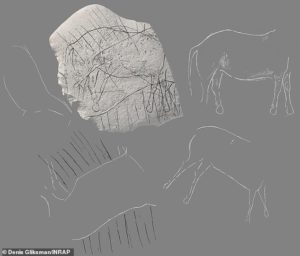‘Exceptional’ prehistoric stone engraved with horses that’s believed to be 12,000 years old is found in France, alongside rudimentary fireplaces, animal bones and a flint carving station
- The finds were unearthed at a dig near Angoulême station, north of Bordeaux
- The main engraving on the stone is of a realistically-depicted headless horse
- Such figurative art from the Azilian culture is rare, as abstract works dominate
- Experts believe that the artists were likely hunters who carved arrowhead
An ‘exceptional’ sandstone tablet covered in engravings of animals and geometric designs has been unearthed from the Angoulême region of southwest France.
Featured on the stone are five animals, mainly horses, one of which is drawn with considerable detail, especially in the features of the animal’s legs.
Archaeologists have dated the stone back to 12,000 years ago, making it a product of the Azilian culture of southern France and northern Spain.
It is rare to find such figurative art from this culture, which typically favoured exclusively abstract iconography.
An ‘exceptional’ sandstone tablet covered in engravings of animals and geometric designs has been unearthed from the Angoulême region of southwest France
The stone was found along with a number of rudimentary fireplaces, animal bones and the remains of a flint carving station.
The prehistoric stone was unearthed by researchers from the French National Institute of Preventive Archaeological Research (Inrap).
They had been excavating a site located near the station in Angoulême, a district to the north of Bordeaux.
The sandstone block is engraved on both sides and features both figurative and abstract geometric designs.
The stone is around 10 inches in length, 7 inches wide and has a thickness of about 1 inch (25x18x3 centimetres).
The most prominent engraving is of a rightward-facing horse, taking up almost half of one side of the stone, whose head and right hind hoof appear to have been lost to the edges of the tablet.
‘The legs and hooves are very realistic, with one of the anterior legs displaying hock, knee, fetlock and likely ergot feathers,’ Inrap said on its website.
‘The legs in the background are positioned in an ambling gait and detached from the animal’s body to create perspective,’ they added.
The back and the rear of the horse have been drawn to follow the natural, curved edges of the stone, while fine incisions on the body appear designed to represent the animal’s coat.



Recent Comments